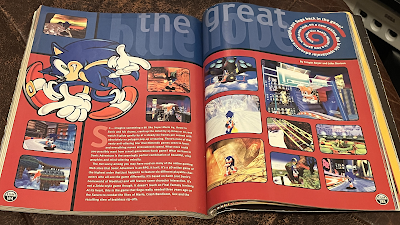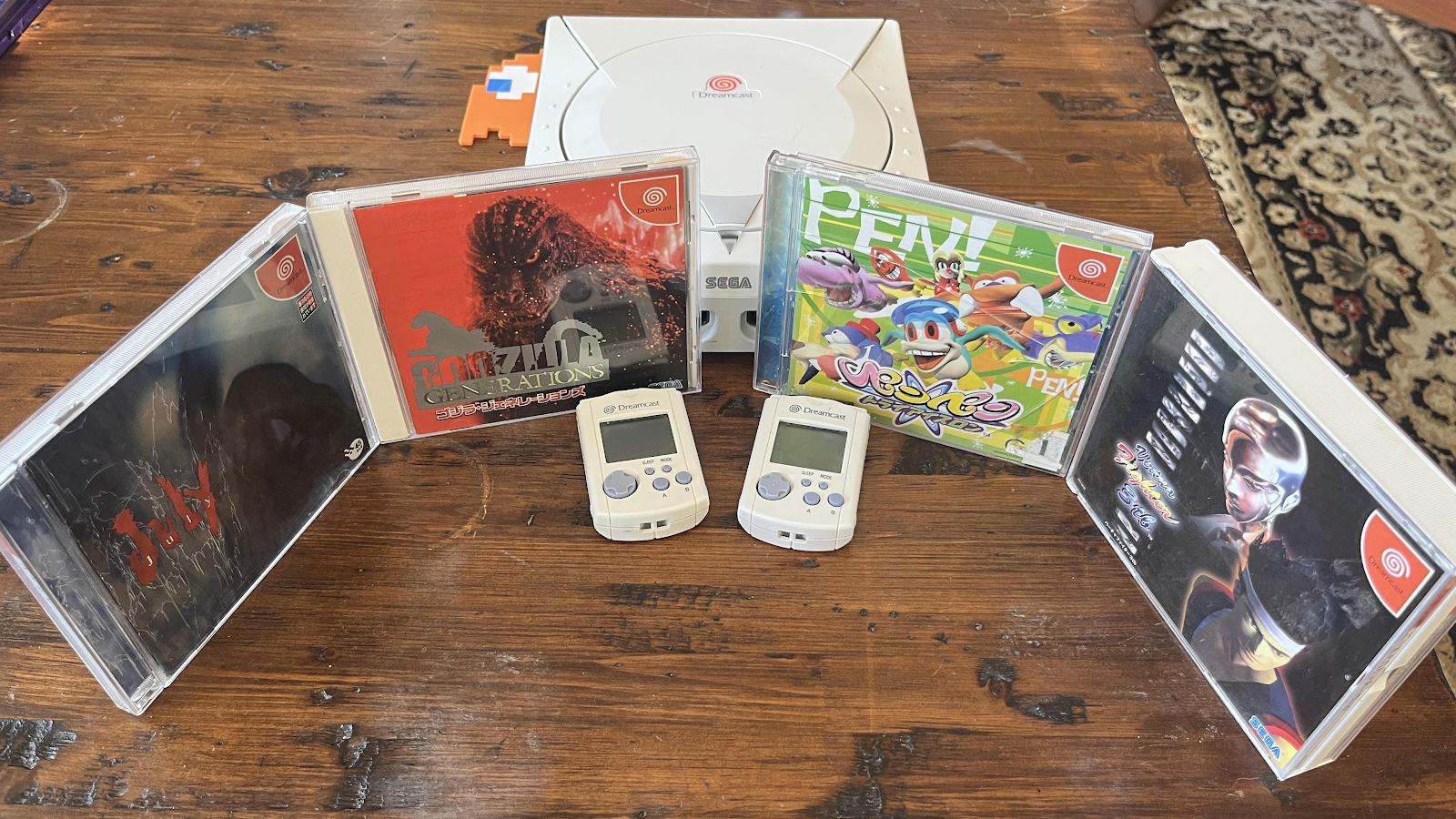Well, shit. It’s been 25 years…or 300 months…or over 13 million minutes. That’s how long it’s been since Godzilla Generations was unleashed in Japan.
And the Dreamcast, too, for that matter.
 |
| In our house, it's always November 27th, 1998. |
I was a tween when I first learned of Sega’s swansong console. Undeterred by President Shoichiro Irimajiri’s creepy disembodied head at the initial Dreamcast reveal, it was ultimately Sonic Adventure which ignited my hype for the platform and all the ambitious and imaginative experiences that would come to define it.
 |
| (From EGM #112 November 1998) Don’t tell tween me that middle-aged me kept this tattered mag. He’d think it was weird and sad and he’d probably be right. |
But the blue ‘hog was just the tip of the spear. With unprecedented visual and aural fidelity, groundbreaking online capabilities, intuitive hardware architecture, and a supplemental operating system, the Dreamcast fancied itself as both a developer-friendly haven and bleeding-edge forerunner of gaming’s future.
 |
| (Preserved by Unseen64.net) |
Elsewhere on the software front, Virtua Fighter 3tb, Get Bass/Sega Bass Fishing, and Sega Rally 2 signaled a renewed commitment to Sega’s iconic arcade experiences at home. Blue Stinger, Pen Pen TriIcelon, and Climax Landers (eventually released as Time Stalkers in the West) flaunted their vibrancy and helped crystallize the Dreamcast’s aesthetic. AM2’s Shenmue – known as 'Project Berkley' at the time – promised to help reimagine how players might inhabit dense and bustling virtual spaces. Meanwhile, the presence of Biohazard: Code Veronica and D2 hinted at resurgent third party support from large and small game makers alike. And Godzilla Generations…was also there.
Although most of Sega’s in-house projects had yet to be unveiled in depth, they’d go on to spark a creative and innovative renaissance that continues to endear the Dreamcast to us a full 2.5 percent of a millennium later.
 |
| (From EGM's 1999 Video Game Buyer's Guide) Some of the other games I was looking forward to. |
In the meantime, Sega faced hurricane-force headwinds as it prepared to get the thing off the ground. The community has expressed no shortage of anecdotes for all the challenges stacked against the company at the time. Among them, people often blame the following:
- Sega’s dwindling financial resources (i.e. capitalism*);
- A merciless competitive landscape amid Sega’s diminished command of industry trends (also capitalism*);
- The upcoming launch of the PlayStation 2 (capitalism strikes again!*);
- Intracompany divisions over the direction and priorities for the Dreamcast across regions;
- Sega's squandered goodwill with publishers, manufacturing partners, retailers, and consumers through several generations of missteps;
- Minimal time to prepare for the Japanese launch, yielding a meager day one lineup and delays for several would-be launch window titles;
- Shifting tides in consumer sentiment (sometimes people just like other things, you know?)
- Sega being Sega;
- Obama.
* I mean, maybe Sega just sucked at capitalism and that's totally OK. Would we really love the Dreamcast as much today if it had been managed by a more fiscally responsible and risk-averse company?
To me, Sega’s biggest challenges of the era were inseparable from its identity. The company’s deep-rooted stubbornness and rebelliousness – while enabling its uncompromising creativity and ambition – led it to hang its fortunes on innovations the public was not yet ready to embrace (e.g. online console gaming). At the same time, Sega continued to cling to established conventions which had fueled its past success and legacy but were falling swiftly out of vogue, globally (e.g. its arcade-centric ethos). In straddling the future and past, Sega found itself awkwardly out of step with gaming's present. Sega was a perpetual pioneer yet it struggled to meet people where they were, or adapt enough to counter its competitors’ most basic strategies to woo them. Sadly — insomuch as we can feel sad for a for-profit corporation — the world was growing ambivalent to Sega’s presence and there wasn’t much anyone could do about it.
 |
| (From the What's Shenmue? Dreamcast demo) |
In many ways, the Dreamcast’s Japanese launch reflected the history of this turmoil. And charmingly, Sega owned it. The company responded by promoting the platform in perhaps the most human way imaginable. Senior Managing Director Hidekazu Yukawa (R.I.P.) became the literal face of the Dreamcast to the point his image was emblazoned on a later edition of the console’s retail box. People knew him as Mr. Sega.
Sega’s Japanese Dreamcast advertising campaign was unconventionally humble and earnest, a likely reflection of Yukawa-san himself. Abandoning the brutish bluster of Segata Sanshiro’s salesmanship, Yukawa wore a friendlier face and carried a more genuine demeanor. Acknowledging the dire situation Sega found itself in, he made a gentler appeal to players. He was simply grateful for the chance they may invite the Dreamcast into their homes.
The Yukawa TV ads rolled with the punches with humility if not grace. In an early spot, demon children haunted Yukawa’s nightmares, exclaiming they didn’t need Sega just before a rift opened and swallowed him into an abyss. And when production challenges hobbled Sega’s ability to produce enough Dreamcasts to meet retail targets, Yukawa-san dedicated an ad to apologizing for the stock shortages while fans pelted him with trash (gamers, amirite?). Meanwhile, his wife wondered when he’d be done with making all these stupid commercials. It was a pitiful ad campaign in that Yukawa-san and Sega actively solicited our pity.
So yeah. Sega was having a rough time even without a new generation of competition looming in the next millennium. As such, the company aimed to seize as much of a head start as possible, hastening the Dreamcast to the Japanese market just to get it out into the world. No doubt Sega of Japan needed to start generating revenue and building a user base sooner rather than later. So as a byproduct of that, there was little time to develop games ahead of the Japanese launch. In fact, the Dreamcast rolled out with four whole titles on day one.
 |
| The Dreamcast lobster |
I recently revisited those Japanese launch games, so I'll ramble about them next...







